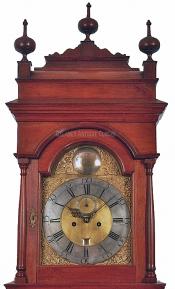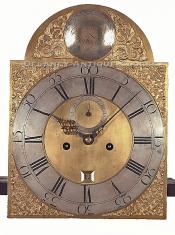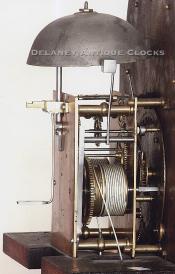John Wood SR. of Philadelphia, Pennsylvania. An important Queen Anne figured walnut case tall clock made circa 1740. LL-146.
This wonderful Queen Anne walnut case stands on applied straight bracket feet. The base is constructed with two panels that are joined at the center. The panels were selected for their vibrant crotch grain pattern and were positioned in a book-matched fashion. As a result, the grain pattern radiates up and out from the clock's center. The waist is long and appears narrow. The frame is constructed with mitered corners. The tombstone-shaped waist door is trimmed with a molded edge. The door is large enough to fill the majority of the waist component of this case. It exhibits a long crotch selection of grain that runs the entire length of this door. Ogee moldings transition the waist to the hood or bonnet section. Here, the sarcophagus top supports three turned ball-and-spike finials. These are mounted on square plinths. Decorative solid frets flank the center example. A bold molding and a tympanum are positioned above the arched door that is appropriately fitted with glass. This detail is also used on the sides of the hood. The two front colonnettes are decoratively turned and engaged with the hood door. Two additional colonnettes are positioned at the back of the hood.
This composite brass dial features a signature plate inscribed by John Wood, Sr. (d. 1761). He is one of the most prominent clockmakers working in Philadelphia during the first half of the eighteenth century. This clock exhibits a cast brass dial sheet that was hammered flat. Additional brass castings are then applied to it to form the presentation of time. The chapter ring, seconds ring, interior calendar ring, and convex name boss are treated with a silver wash for contrast with the yellow color of the brass. The cast-brass spandrels are decorated with urns and arabesques, and cast dolphin ornaments flank the signature plate. The center of the dial is lightly textured. The hands a wonderfully formed. They are steel and have been blued.
The movement is constructed in brass. The front plate is somewhat rough. These plates are supported by smoothly turned brass posts. They are secured through the front plate with latches. The gearing is brass, and the pinions are steel. The movement is weight driven and designed to run for eight days on a full wind. This clock strikes the hour on a bell. The strike train is located between the plates and is actuated by a rack and snail design. The winding barrels grooved. A seaboard supports the movement.
This is a fine example made by a well-known Philadelphia Clockmaker circa 1740. This example stands an impressive 8 feet 10 inches or 106 inches tall overall. It is approximately 21 inches wide and 10 inches deep.
It is inventory number LL-146.
The clockmakers John Wood Sr., Peter Stretch and Joseph Wills are considered the three most significant Pennsylvania clocks makers of the first half of the 1700's. For John Wood, no birth dates are currently known. We do know that he was at work as early as 1729 and died in 1760-61. John Wood Sr. advertised his business in the Pennsylvania Gazette as early as 1734 and continued to operate his establishment at the corner of Front and Chestnut streets, in a shop that had originally belonged to Peter Stretch, until his death in 1761. He had a son John Wood Jr who was also a clock maker to whom he willed his tools and house.
There are a small number of John Wood tall case clocks in public collections. One fine example can be found at the Metropolitan Museum of Art with a history of descent in the family of Joseph Barber (about 1763-1830) of Princeton, New Jersey.
For a more in depth discussion of John Wood and early brass dial American clocks, Please read Frank Hohmann's, Timeless \/ MASTERPIECES AMERICAN BRASS DIAL CLOCKS.




















